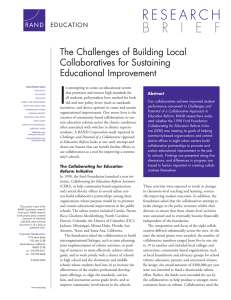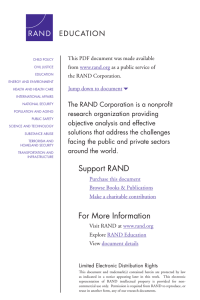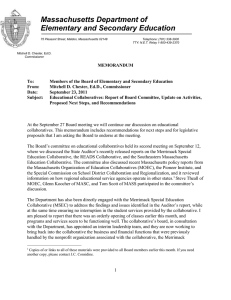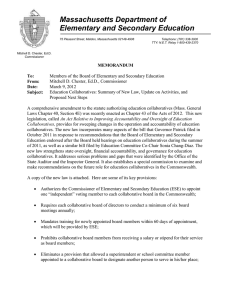September 2004
advertisement
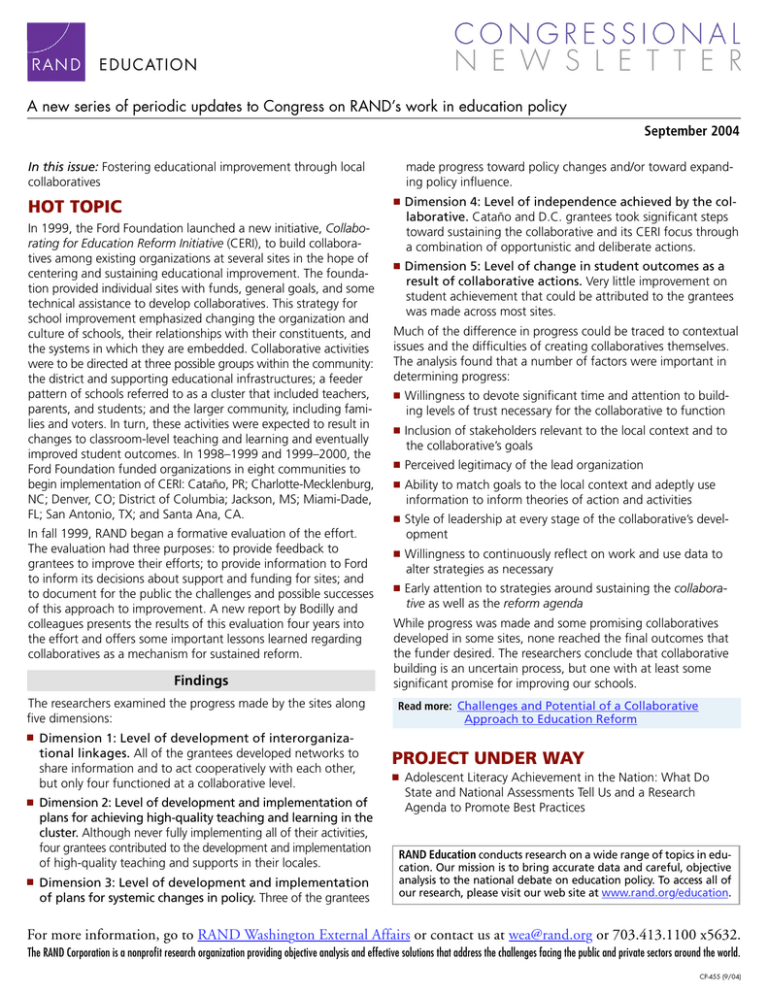
A new series of periodic updates to Congress on RAND’s work in education policy September 2004 In this issue: Fostering educational improvement through local collaboratives HOT TOPIC In 1999, the Ford Foundation launched a new initiative, Collaborating for Education Reform Initiative (CERI), to build collaboratives among existing organizations at several sites in the hope of centering and sustaining educational improvement. The foundation provided individual sites with funds, general goals, and some technical assistance to develop collaboratives. This strategy for school improvement emphasized changing the organization and culture of schools, their relationships with their constituents, and the systems in which they are embedded. Collaborative activities were to be directed at three possible groups within the community: the district and supporting educational infrastructures; a feeder pattern of schools referred to as a cluster that included teachers, parents, and students; and the larger community, including families and voters. In turn, these activities were expected to result in changes to classroom-level teaching and learning and eventually improved student outcomes. In 1998–1999 and 1999–2000, the Ford Foundation funded organizations in eight communities to begin implementation of CERI: Cataño, PR; Charlotte-Mecklenburg, NC; Denver, CO; District of Columbia; Jackson, MS; Miami-Dade, FL; San Antonio, TX; and Santa Ana, CA. In fall 1999, RAND began a formative evaluation of the effort. The evaluation had three purposes: to provide feedback to grantees to improve their efforts; to provide information to Ford to inform its decisions about support and funding for sites; and to document for the public the challenges and possible successes of this approach to improvement. A new report by Bodilly and colleagues presents the results of this evaluation four years into the effort and offers some important lessons learned regarding collaboratives as a mechanism for sustained reform. Findings The researchers examined the progress made by the sites along five dimensions: ■ ■ ■ Dimension 1: Level of development of interorganizational linkages. All of the grantees developed networks to share information and to act cooperatively with each other, but only four functioned at a collaborative level. Dimension 2: Level of development and implementation of plans for achieving high-quality teaching and learning in the cluster. Although never fully implementing all of their activities, four grantees contributed to the development and implementation of high-quality teaching and supports in their locales. Dimension 3: Level of development and implementation of plans for systemic changes in policy. Three of the grantees made progress toward policy changes and/or toward expanding policy influence. ■ Dimension 4: Level of independence achieved by the collaborative. Cataño and D.C. grantees took significant steps toward sustaining the collaborative and its CERI focus through a combination of opportunistic and deliberate actions. ■ Dimension 5: Level of change in student outcomes as a result of collaborative actions. Very little improvement on student achievement that could be attributed to the grantees was made across most sites. Much of the difference in progress could be traced to contextual issues and the difficulties of creating collaboratives themselves. The analysis found that a number of factors were important in determining progress: ■ Willingness to devote significant time and attention to building levels of trust necessary for the collaborative to function ■ Inclusion of stakeholders relevant to the local context and to the collaborative’s goals ■ Perceived legitimacy of the lead organization ■ Ability to match goals to the local context and adeptly use information to inform theories of action and activities ■ Style of leadership at every stage of the collaborative’s development ■ Willingness to continuously reflect on work and use data to alter strategies as necessary ■ Early attention to strategies around sustaining the collaborative as well as the reform agenda While progress was made and some promising collaboratives developed in some sites, none reached the final outcomes that the funder desired. The researchers conclude that collaborative building is an uncertain process, but one with at least some significant promise for improving our schools. Read more: Challenges and Potential of a Collaborative Approach to Education Reform PROJECT UNDER WAY ■ Adolescent Literacy Achievement in the Nation: What Do State and National Assessments Tell Us and a Research Agenda to Promote Best Practices RAND Education conducts research on a wide range of topics in education. Our mission is to bring accurate data and careful, objective analysis to the national debate on education policy. To access all of our research, please visit our web site at www.rand.org/education. For more information, go to RAND Washington External Affairs or contact us at wea@rand.org or 703.413.1100 x5632. The RAND Corporation is a nonprofit research organization providing objective analysis and effective solutions that address the challenges facing the public and private sectors around the world. CP-455 (9/04)




